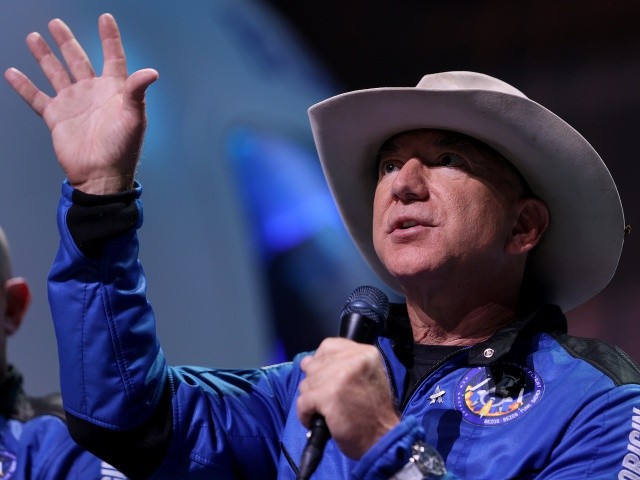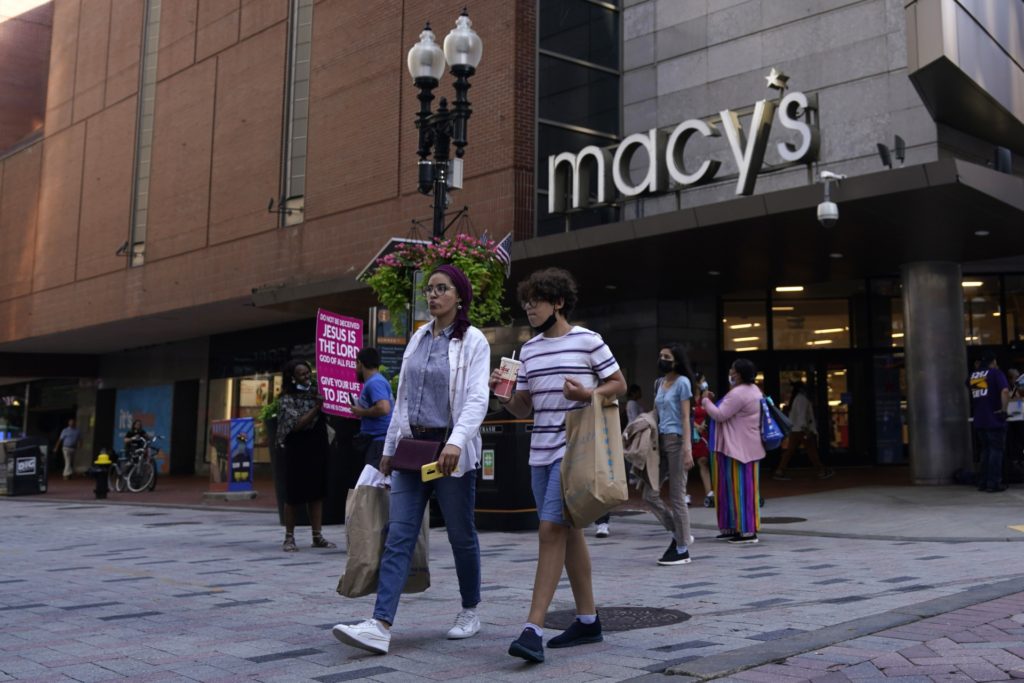Tech and e-commerce giant Amazon reportedly plans to open multiple large physical stores across the United States that will operate similarly to department stores. Amazon is already the largest seller of clothing in the United States.
The Wall Street Journal reports that Amazon plans to open multiple large physical retail locations in the United States similar to department stores. The decision comes as the company aims to increase the sales of its clothing, household items, electronics, and other products.
VAN HORN, TEXAS – JULY 20: Jeff Bezos speaks about his flight on Blue Origin’s New Shepard into space during a press conference on July 20, 2021 in Van Horn, Texas. Mr. Bezos and the crew that flew with him were the first human spaceflight for the company. (Photo by Joe Raedle/Getty Images)
It is expected that some of the first locations will open in Ohio and California. The retail spaces will be around 30,000 square feet, which is smaller than the average department store — which spans around 100,000 feet. The Amazon stores will still be a huge increase in terms of size over its Amazon Go grocery stores and will reportedly look something like a scaled-down Bloomingdale or Nordstrom store.
It is expected that the Amazon stores will stock top brands as well as the company’s own private-label products. Currently, Amazon is the largest seller of clothing in the United States, according to Wells Fargo & Co.
Department stores have seen a major decline in popularity in recent years, partially caused by the rise in e-commerce that Amazon contributed heavily to. 25 years ago, department stores accounted for about 10 percent of all retail sales, excluding automobiles, gas, and restaurants. According to analysis from the consulting firm Customer Growth Partners, they now account for less than one percent.
As the coronavirus pandemic grew, department stores took an even bigger hit with many shoppers reluctant to visit physical locations. Companies such as J.C. Penney, Neiman Marcus Group Inc., Lord & Taylor, and Stage Stores Inc. were all forced to file for bankruptcy.
In this July 14, 2021 file photo, pedestrians pass the Macy’s store in the Downtown Crossing shopping area, in Boston. Americans cut back on their spending last month as a surge in COVID-19 cases kept people away from stores. Retail sales fell a seasonal adjusted 1.1% in July from the month before, the U.S. Commerce Department said Tuesday, Aug. 17. (AP Photo/Charles Krupa, File)
But analysts are expecting that department stores will be around for some time. It’s expected that chains including Macy’s and Kohl’s will report strong sales in the coming months as many shoppers rush to restock on clothing after reducing purchases last year.
Read more at the Wall Street Journal here.
Lucas Nolan is a reporter for Breitbart News covering issues of free speech and online censorship. Follow him on Twitter @LucasNolan or contact via secure email at the address lucasnolan@protonmail.com
Amazon’s 25th anniversary: A conglomerate based on parasitism and exploitation Last week, Amazon commemorated its 25th anniversary. From its beginnings in a garage in Seattle, Washington, Amazon has grown into a multinational technology conglomerate with a market capitalization of nearly one trillion dollars.
In 1994, future Amazon CEO Jeff Bezos left his job at hedge fund D.E. Shaw to get out in front of the possibilities opened up by the accelerating development of the internet, beginning with the modest idea of an online bookstore. Bezos went on to become the wealthiest man on the planet, his hoard by one estimate peaking at a record $157 billion before his assets were divided in a divorce earlier this year.
Now considered one of the “Big Four” technology monopolies alongside Apple, Google and Facebook, Amazon controls the largest marketplace on the Internet: Amazon.com. The conglomerate’s reach extends from Whole Foods Market, which Amazon purchased in 2017 for $13.4 billion, to consumer electronics such as the Kindle reader and the voice-controlled Alexa. Amazon subsidiary Kuiper Systems announced in April of this year that it will spend a decade launching 3,236 satellites into space to provide broadband internet.
Traditional book publishers were decimated by the arrival of Amazon, which aggressively pursued them, in the words of Bezos, “the way a cheetah would pursue a sickly gazelle.” Using its vast flows of cash, Amazon ruthlessly undercut its rivals, from neighborhood stores to diaper manufacturers, accepting losses in order to drive competitors out of its way. Meanwhile, Amazon demanded and obtained free money from state and local governments in the form of tax breaks and other concessions.
Amazon’s annual revenues reached $233 billion in 2018, on which the conglomerate is expected to pay zero federal income tax. To put this figure in perspective, these revenues are nearly at the level of the annual tax revenue of Russia, which amounted to $253.9 billion in US dollars in 2017. Amazon’s revenues are higher than the government revenues of Turkey ($173.9 billion), Austria ($197.8 billion), Poland ($90.8 billion) and Iran ($77.2 billion).
Nearly half of American households now have subscriptions to Amazon Prime. The click of a mouse on a personal computer, or the tap of a finger on a mobile device, now sets into motion the speedy delivery of commodities from around the world, or the instantaneous electronic transmission of a film, song or book. Behind these deceptively simple transactions lies Amazon’s vast and complex commercial, logistics, distribution and computing empire.
Promising advances have indeed been made in automation and artificial intelligence. These technological advances carry with them tremendous liberating potential for human civilization as a whole. Heavy and repetitive toil by humans can increasingly be mitigated by robots, and possibilities appear on the horizon for advanced levels of coordination and integration around the world, assisted by artificial intelligence.
But under capitalism, new advances in technology have made possible new techniques of exploitation. Amazon has become a watchword for a new kind of despotism in the workplace.
In Amazon “fulfillment centers,” workers are forbidden to carry cellphones or to talk to each other. They are searched coming in and out, and minute details of their activity throughout the workday are tracked. Amazon specializes in putting constant pressure on workers to move as fast as possible, with electronic devices constantly prompting and prodding them to complete the next task.
Workers are instructed to compete with each other to surpass each other’s rates, which they are admonished constitutes “fun.” Arbitrarily high rates are demanded, and then raised, and then raised again. A worker who takes a moment to rest, to drink water, or to go to the bathroom can be criticized for a diminished rate. The workers who are deemed too slow, or who simply tire out, are replaced.
Amazon is now the second-largest employer in the United States, and there are around 647,000 Amazon workers worldwide. Journalist John Cassidy, writing about Amazon in The New Yorker in 2015, commented: “Behind all the technological advances and product innovation, there is a good deal of old-fashioned labor discipline, wage repression, and exertion of management power.”
Over the past week, the World Socialist Web Site published an article exposing the injury of 567 workers over a two-year period at Amazon’s DFW-7 fulfillment center near Fort Worth, Texas. In December of last year, the WSWS reported how Amazon had hired a private detective to spy on 27-year-old worker Michelle Quinones in an effort to block compensation for her injury.
Amazon has appeared in the “Dirty Dozen” list maintained by the National Council for Occupational Safety and Health (National COSH) for two years in a row. The 2019 report highlights six worker deaths in seven months, 13 deaths since 2013, “a high incidence of suicide attempts, workers urinating in bottles and workers left without resources or income after on-the-job injuries.”
Amazon’s techniques are merely a refined expression of conditions being imposed on workers around the world. In March of this year, Ford Motor Company announced the hiring of its new chief financial officer, Tim Stone, who previously served as Amazon’s vice president of finance and the leader of the Amazon’s acquisition of Whole Foods. Stone was hired as Ford carries out brutal cost-cutting in the US, Europe and around the world.
There is no shortage of opposition among Amazon workers. On social media, current and former Amazon workers are contacting each other, looking for ways to fight back. In Poland, where Amazon workers make around $5 per hour, Amazon walked out of negotiations on July 2 with two unions over working conditions, setting the stage for a strike.
To fight for their interests, Amazon workers cannot allow their struggles to be corralled and smothered by the pro-capitalist trade unions, which are doing everything they can to block a fight against inequality and exploitation. The WSWS fights for the building of independent, rank-and-file workplace committees to unite Amazon workers throughout the world with all workers in a common counteroffensive.
The key to the struggle of Amazon workers is an understanding that the fight against Amazon is a fight against the capitalist system itself. In 25 years, Amazon produced the biggest individual fortune in history, and it did so on the backs of hundreds of thousands of workers. In the words of Karl Marx, Amazon’s trajectory represents an “accumulation of misery, corresponding with accumulation of capital.”
Not just Bezos, but many others have enriched themselves or stand to enrich themselves from Amazon’s rise. Wall Street has its fingers in the pie. The Vanguard Group currently owns $55 billion of Amazon stock, BlackRock owns $45 billion and FMR owns $30 billion.
The parasitic activities of Amazon, through which it has sought to appropriate for itself the surplus value accumulated by other companies, have been integrated with the financial parasitism of the American economy. Amazon’s own stock has been buoyed ever higher as part of the speculative mania on Wall Street.
Amazon is entangled not only with Wall Street, but also with the US military and intelligence apparatus. Amazon was awarded a $600 million contract with the CIA in 2013, followed by a $10 billion contract with the Department of Defense last year to move government data onto the cloud. Meanwhile, Amazon’s facial-identification software “Rekognition” is being marketed to federal and local police.
In 2013, Bezos personally purchased, and now operates, the Washington Post , which has been a main media voice for the Democratic Party’s anti-Russia campaign and the overall interests of American imperialism.
The increasing integration of Amazon with the repressive apparatus of the state, while its tentacles stretch into every corner of society, confirms the Marxist understanding of the relationship between capitalism and democracy in the modern epoch. “Finance capital does not want liberty, it wants domination,” wrote Austrian Marxist Rudolf Hilferding, in a passage quoted by Lenin in Imperialism: The Highest Stage of Capitalism .
Amazon must be placed under public ownership and democratic control. It must be taken out of the hands of the financial oligarchy and transformed into a public utility. The technology and infrastructure behind Amazon’s meteoric trajectory and the biggest individual fortune in modern history must be turned towards the needs and aspirations of the world’s population as a whole.
This program can only be achieved through the mobilization of the working class on an international scale on the basis of a fight to overthrow the capitalist system and establish a democratically-controlled socialist economy, run on the basis of social need, not private profit.
The Amazonification the U.S. Economy: Data Hosting, Warehousing, Courier Services Explode Higher Joe Raedle /Getty 2:39
Call it the Amazonification of the U.S. economy.
The fastest-growing sectors of the U.S. economy over the course of the pandemic have been courier services, data processing and hosting, warehousing, and trucking, the Commerce Department’s quarterly report on the services sector showed Thursday.
These are, of course, the areas of the economy associated with the shift in services spending toward online retail, of which Amazon is by far the biggest online retailer and a giant in data hosting through its Amazon Web Services arm.
Courier services revenue grew 38.1 percent between the second quarter of 2019 and the second quarter of 2021. Data processing and hosting grew 38 percent. Warehousing revenue grew 34 percent. Trucking revenue grew 22 percent.
(Photo by Joe Raedle/Newsmakers)
Comparing the second quarter of 2019 with the second quarter of 2021 allows for analysis of the pre-pandemic period to the most recently completed figure. Because the data are seasonally adjusted, however, similar results show up if the most recent quarter is compared with the fourth quarter of 2019.
In comparison with the fourth quarter of 2019, the last full quarter with no pandemic effect, courier services are still the leader at 31.9 percent. Data processing is up 26.4 percent. Trucking is up 26.5 percent. Warehousing is up 20 percent.
Many of these services are still growing rapidly. Data processing and hosting rose 7.7 percent in the April through June period compared with the first three months of the year. Courier services sales grew 4.2 percent. Warehousing grew 4.5 percent. Trucking grew 13.6 percent.
By contrast, other areas of the economy continue to languish. Revenue for motion pictures and recorded music are down 17.9 percent from the spring of 2019. Hotels and motel revenue are down 14 percent. Revenue in the category of arts, entertainment, and recreation is 18.4 percent. Air travel revenue have fallen 31.5 percent.
MELROSE PARK, ILLINOIS – DECEMBER 04: An empty parking lot surrounds a Cinemark theater shuttered by the coronavirus COVID-19 in Melrose Park, Illinois. (Photo by Scott Olson/Getty Images)
But these are recovering. Air travel revenue grew 48.7 percent on a quarterly basis. Accommodations revenue was up 47.8 percent. Arts and entertainment rose 22.6 percent.



No comments:
Post a Comment